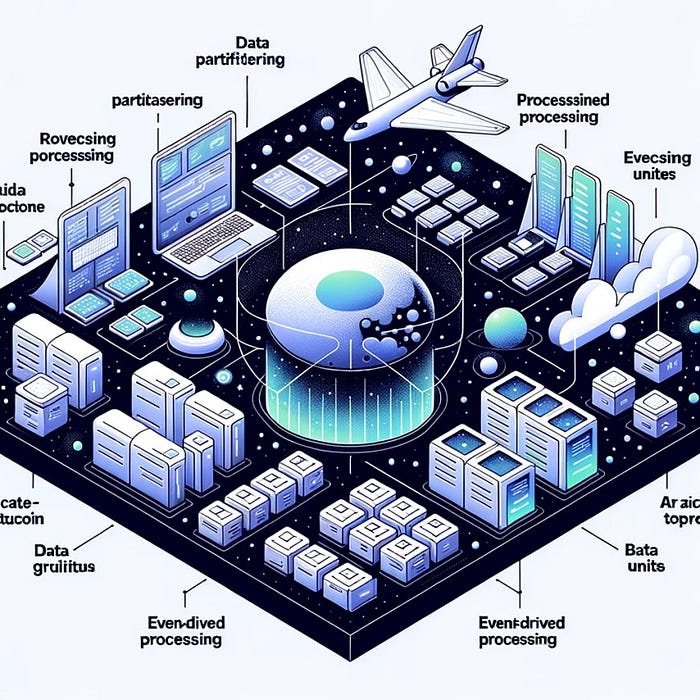Space-Based Architecture: Enabling Scalable and Distributed Systems

In the ever-evolving world of software architecture, the quest for scalability and high availability has led to the adoption of various architectural patterns. One such pattern, which has gained traction in distributed systems, is the Space-Based Architecture (SBA). Rooted in the principles of parallel processing and data partitioning, SBA promises to address the challenges posed by high-demand, large-scale applications.

Core Concepts of Space-Based Architecture
1. Tuple Space: At the heart of SBA lies the concept of a tuple space, a repository that allows storage and retrieval of data tuples. It acts as a shared memory for processes, enabling asynchronous communication.
2. Processing Units: The architecture divides the processing into self-sufficient units, each handling data storage, processing, and messaging. This decentralization is key to SBA’s scalability.
3. Data Partitioning: To ensure data availability and fault tolerance, data is partitioned across multiple processing units. This not only balances the load but also provides redundancy.
Advantages of Adopting Space-Based Architecture
1. Scalability: By design, SBA is meant to scale out rather than up. As the demand increases, more processing units can be added seamlessly.
2. High Availability: The distributed nature, combined with data partitioning, ensures that even if a few processing units fail, the system remains operational.
3. Flexibility: The modular structure allows for independent deployment and scaling of different parts of an application.
4. Reduced Data Bottlenecks: Traditional architectures often face data bottlenecks, especially with databases. SBA, with its distributed data approach, mitigates this challenge.
Space-Based Architecture in Modern Systems
With the rise of cloud computing and microservices, the principles of SBA have found relevance in modern system designs:
1. Microservices and SBA: The decentralized nature of both microservices and SBA makes them natural allies. Each microservice can be visualized as a processing unit in SBA, with its own data store and messaging system.
2. Cloud Deployments: Cloud platforms, with their inherent scalability and distributed nature, are apt for SBA implementations. Platforms like AWS and Azure offer services that resonate with the SBA principles.
3. Event-Driven Systems: Event-driven architectures, where components react to events, align well with SBA. The tuple space can act as an event store, with processing units reacting to stored events.
Challenges and Considerations
While SBA offers numerous benefits, it’s not devoid of challenges:
1. Complexity: Building a true Space-Based system can be complex, especially when ensuring data consistency across processing units.
2. Data Integrity: Ensuring data integrity, especially in high-transaction systems, can be a challenge given the distributed nature of data.
3. Debugging and Monitoring: Given the decentralized structure, monitoring and debugging can be more intricate compared to monolithic systems.
Conclusion
Space-Based Architecture, with its emphasis on scalability and high availability, has emerged as a reliable choice for large-scale, high-demand applications. Its principles, while challenging to implement, offer long-term benefits, especially in today’s cloud-centric world. As with any architectural style, it’s crucial to weigh the pros and cons and consider the specific requirements of a project before adopting SBA.
Implementing Space-Based Architecture
Successfully deploying a Space-Based Architecture requires adherence to certain principles and best practices. These guidelines ensure the system’s robustness, scalability, and fault tolerance.
1. Efficient Data Partitioning
Data partitioning is pivotal in SBA:
2. Asynchronous Communication
Given the distributed nature of SBA, asynchronous communication becomes crucial:
3. Load Balancing
To ensure optimal performance and resource utilization:
4. Fault Tolerance and Recovery
The distributed nature of SBA offers inherent fault tolerance, but it’s essential to optimize recovery mechanisms:
5. Monitoring and Observability
Given the complexities of SBA, robust monitoring becomes paramount:
Future Trends in Space-Based Architecture
As technology continues to evolve, SBA is poised to adapt and innovate:
Integration with Edge Computing
As computation moves closer to data sources, SBA’s principles can be applied to edge computing, ensuring real-time processing and reduced data transfer costs.
AI and Space-Based Systems
Artificial Intelligence can be integrated with SBA to optimize data distribution, load balancing, and fault recovery, making the system more intelligent and adaptive.
Space-Based Architecture and Databases
The intersection of SBA with databases has led to the development of new paradigms that cater to the unique challenges of distributed systems.
1. In-Memory Data Grids (IMDG)
IMDGs are distributed data structures that store data across multiple nodes, offering low-latency access and high availability:
2. NoSQL Databases and SBA
NoSQL databases, with their flexible schemas and scalability, resonate with SBA principles:
3. Data Consistency in Space-Based Systems
Ensuring data consistency across distributed nodes is a challenge:
4. Optimizing Data Retrieval in SBA
With data distributed across multiple nodes, optimizing data retrieval becomes crucial:
Space-Based Architecture in Hybrid Systems
Hybrid systems combine the features of multiple architectural styles, and SBA can play a pivotal role in such setups:
Integration with Service-Oriented Architecture (SOA)
SOA focuses on delivering services over a network, and its principles can be combined with SBA:
SBA and Event-Driven Architectures (EDA)
EDA revolves around the production, detection, and reaction to events:
Given the complexities of SBA:

Originally published at https://khnext.com on October 22, 2023.
